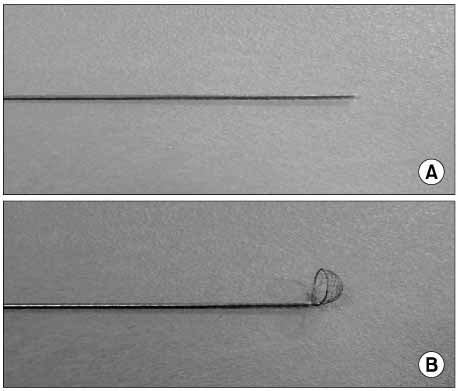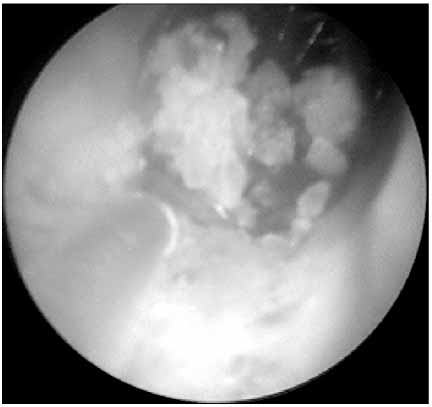Korean J Urol.
2007 Nov;48(11):1161-1164. 10.4111/kju.2007.48.11.1161.
Efficacy of the NTrap(R) for the Treatment of Ureteral Stone: An Initial Clinical Experience
- Affiliations
-
- 1Department of Urology, College of Medicine, Chosun University, Gwangju, Korea. mu-hn@hanmail.net
- KMID: 1997094
- DOI: http://doi.org/10.4111/kju.2007.48.11.1161
Abstract
-
PURPOSE: Retrograde migration of stone fragments is common when performing lithotripsy. A new device, the NTrap(R), is a device that prevents stone migration and it extracts calculi and other foreign bodies in the urinary tract. The aim of this study was to assess the efficacy and safety of ureteroscopic stone removal by using the NTrap(R).
MATERIALS AND METHODS
From January 2006 to December 2006, 64 consecutive patients underwent endoscopic lithotripsy by using the NTrap(R), rigid ureteroscopy(8.6Fr) and pneumatic lithoclast. We analyzed the success rate of stone removal and the complication rate.
RESULTS
The mean stone size and mean operation time were 9.36mm and 32 minutes, respectively. The overall stone-free rate was 100% and no patient had residual fragments greater than 3mm and they didn't require auxiliary treatment. The most common complications were gross hematuria and pain.
CONCLUSIONS
The NTrap(R) is new ureteroscopic instrument that's a highly effective, safe modality for the treatment of ureteral stone.
Keyword
MeSH Terms
Figure
Reference
-
1. Singal RK, Denstedt JD. Contemporary management of ureteral stones. Urol Clin North Am. 1984. 23:59–66.2. Netto Junior NR, Claro JF, Lemos GC, Cortado PL. Treatment options for ureteral calculi: endourology or extracorporeal shock wave lithotripsy. J Urol. 1991. 146:5–7.3. Higashihara E, Horie S, Takeuchi T, Kameyama S, Asakage Y, Hosaka Y, et al. Laser ureterolithotripsy with combined rigid and flexible ureterorenoscopy. J Urol. 1990. 143:273–274.4. Dretler SP. An evaluation of ureteral laser lithotripsy: 225 consecutive patients. J Urol. 1990. 143:267–272.5. Holley PG, Sharma SK, Perry KT, Turk TM. Assessment of novel ureteral occlusion device and comparison with stone cone in prevention of stone fragment migration during lithotripsy. J Endourol. 2005. 19:200–203.6. Bagley DH, Kuo RL, Zeltser IS. An update on ureteroscopic instrumentation for the treatment of urolithiasis. Curr Opin Urol. 2004. 14:99–106.7. Ouwenga MK, Sharma SK, Holley P, Turk TM, Perry KT. Load-release points of two novel ureteral stone-trapping devices. J Endourol. 2005. 19:894–897.8. Chaussy C, Schmiedt E, Jocham D, Brendel W, Forssmann B, Walther V. First clinical experience with extracorporeally induced destruction of kidney stone by shock waves. J Urol. 1982. 127:417–420.9. Politis G, Griffith DP. ESWL. Stone-free efficacy based upon stone size and location. World J Urol. 1987. 5:225–228.10. Yaycioglu O, Guvel S, Kilinc F, Egilmez T, Ozkardes H. Results with 7.5F versus 10F rigid ureteroscopes in treatment of ureteral calculi. Urology. 2004. 64:643–647.11. Schulze H, Haupt G, Piergiovanni M, Wisard M, von Niederhausern W, Senge T. The Swiss Lithoclast: a new device for endoscopic stone disintegration. J Urol. 1993. 149:15–18.12. Denstedt JD. Use of the Swiss Lithoclast for percutaneous nephrolithotripsy. J Endourol. 1993. 7:477–480.13. Lee KW, Lee TY, Woo YN. The experience of ureterorenoscopic lithotripsy with insertion of ureterorenoscope between two safety guide wires serving as an access port. Korean J Urol. 2003. 44:221–226.14. Lee YK, Park DS, Hong YK. Ureteroscopic lithotripsy with pneumatic lithotriptor: 274 cases. Korean J Urol. 2006. 47:625–630.15. Chung HS, Park JY, Kim HK, Park CM. Efficacy of Stone Cone for treatment of proximal ureteral stones: an initial clinical experience. Korean J Urol. 2006. 47:412–417.16. Holley PG, Sharma SK, Perry KT, Turk TM. Assessment of novel ureteral occlusion device and comparison with Stone Cone in prevention of stone fragment migration during lithotripsy. J Endourol. 2005. 19:200–203.
- Full Text Links
- Actions
-
Cited
- CITED
-
- Close
- Share
- Similar articles
-
- Use of NTrap(R) during Ureteroscopic Lithotripsy for Upper Ureteral Stones
- Clinical Experience with Ureteroscopic Management of Ureteral Calculi Including Electrohydraulic Lithotripsy
- Efficacy of the Stone Cone for Treatment of Proximal Ureteral Stones: an Initial Clinical Experience
- Experience of Ureteroscopic Removal of Ureteral Stone in 35 Cases
- Experience of Rigid Ureteroscopic Removal of Stone



